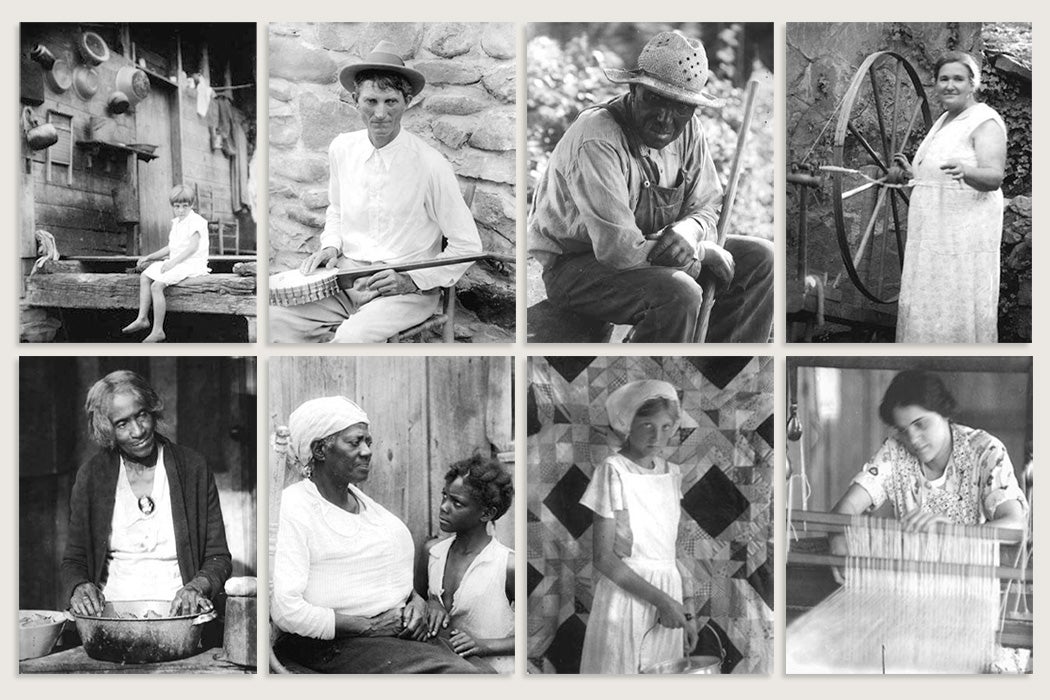In her scarlet silk dress and natty little red hat, Doris Ulmann would have looked right at home in her Park Avenue studio. There, Ulmann, with her ever-present gold-tipped cigarette in her hand, had spent much of the 1920s photographing the literary elite. She had created portraits of Robert Frost, H. L. Mencken, and Edna St. Vincent Millay among countless others, each in her distinctive and laborious pictorialism style.
But standing in the Appalachian heat in the summer of 1933, Ulmann seemed “very exotic,” wrote her friend Olive Dame Campbell. Ulmann’s designer dress, her unwieldy and anachronistic Korona View camera, and her 1929 Lincoln, complete with chauffeur, marked her as an outsider in the small, isolated hamlets that dotted the North Carolina-Tennessee border. That seemingly unbridgeable social divide might have stymied the photographer, whose art relied on creating what she called “a bond of sympathy” with her subjects. Instead, with what her biographer Philip Walker Jacobs called her “own agenda—to create dignified and respectful photographic paintings of individuals who would probably never have the opportunity to sit for a good painter or portraitist or photographer,” Ulmann produced some of the most striking images of her career in the Great Smoky Mountains in the depths of the Great Depression.

Hundreds of these photographs—and more than a thousand others Ulmann created in the 1920s and 1930s—can be found today in archives shared via JSTOR by the University of Oregon. They reveal Ulmann’s shifting artistic focus, from the faces of her own upper-class social circles to those she thought of as the country’s “vanishing types.” The phrase evokes both the passage of time—something Ulmann, with her by-then unfashionable dedication to the posed aesthetics of pictorialism, was keenly aware of—and a sense of erasure. The people Ulmann chose to photograph in the late 1920s and early 1930s were those who were often overlooked in American society. She visited small religious sects in the mid-Atlantic, the Gullah community of coastal South Carolina, Black farmers in Kentucky, and white artisans in Appalachia.

It was this last interest—for Ulmann “rarely took a photograph unless interested in the sitter,” Campbell wrote—which brought Ulmann to the Great Smoky Mountains in 1933 and 1934 to photograph the artists and crafters of the region in preparation for a book on the subject. On one of those trips, Ulmann found her way to Gatlinburg, Tennessee. The town stood at the edge of the Great Smoky National Park, chartered in 1934, but it was still a decade away from becoming a prosperous resort town. When Ulmann, accompanied by John Jacob Niles, a musician collecting traditional songs, rode up Glades Road, at the foot of Mount Le Conte, the entire county was home to just 20,000 people, many subsistence farmers like members of the Owenby family (who also went by “Ownby,” the dropped “e” likely a nod to the vernacular of the region), who had lived in the mountains for generations.

Sometimes in her travels, Ulmann bemoaned her inability to make the connection she needed to with her would-be subjects. Of a trip to Charleston in 1929 to photograph the city’s Black community she wrote, “it is exceedingly difficult to get the studies in which I am interested here.” But from the forty-nine images of the Owenbys in the University of Oregon archives, it’s clear that Ulmann found a bond of sympathy with the family; sitting for Ulmann took time.
“Ulmann believed a better, truer image would emerge from a technical process that required minutes, even hours, than from one that took only seconds,” writes Melissa A. McEuen in Seeing America: Women Photographers between the Wars.

There’s Mary Owenby turning wood and weaving cane to create chairs and baskets. Ulmann’s images of her, with a rough-hewn log house in the background, don’t look a world away from those she took of writers and editors in her Upper East Side studio. She pays the same careful attention to light and shadows, to hands in motion and unguarded expressions. And there’s Pink Owenby, Mary’s brother-in-law, and his wife, Mary. The preacher, in his uneven suspenders, clutches a book and appears to be in conversation. His wife looks directly at the camera, the lines etched in her face telling the whole story.

“A face that has the marks of having lived intensely, that expresses some phase of life, some dominant quality or intellectual power, constitutes for me an interesting face,” Ulmann said in 1930. Most often she found “the face of an older person” to be “more appealing than the face of a younger person who has scarcely been touched by life.” But the subject who seems to have most captivated Ulmann in Gatlinburg that day was Anner Owenby, a distant cousin by marriage to the others, then in her early thirties.

Anner Owenby—born Anner Proffitt—was the epitome of Ulmann’s “vanishing type” in a workaday sun bonnet and striped apron that echoed a much earlier age. In every image she looks pensive, even mournful. In the most memorable of the photographs Ulmann took that day, Anner plays a well-used guitar, her eyes distant. The unheard melody is unmistakably a plaintive one.
Weekly Newsletter
Anner’s face had a story to tell. She had married at sixteen, had lost a daughter, and was raising two young sons with her husband on the family farm at a moment of significant change in her small community. But these photographs also told the story Ulmann wanted to tell. As Jacqueline Francis writes in “Painting the South with a Northern Eye,” Ulmann’s meticulously posed images, sometimes supplemented with props, were “built upon visual stereotypes of the South as the past.” Ulmann felt the loss of this imagined simpler time and made the argument for reclaiming it with her camera.
“I am of course glad to have people interested in my pictures as examples of the art of photography,” Ulmann said,” but my great wish is that these human records shall serve some social purpose.”





